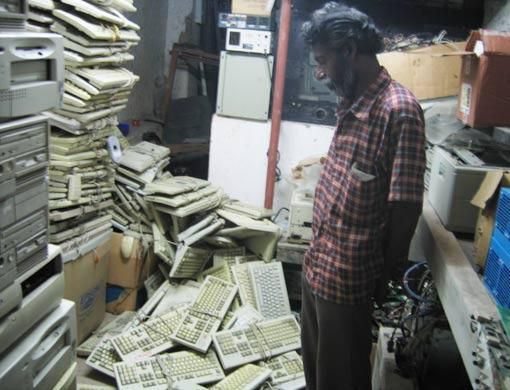Experts say pollution caused by electronic scrap will wreak serious environmental and genetic damage.
By early noon, a semi-opaque blanket of dust and smoke hangs heavy over this city. With more and more automobiles plying on Bangalore's roads, snarling traffic and choking lungs, it isn't surprising, this is one of the ten most polluted cities in India.
For environmentalists, however, emissions from vehicles no longer top pollution concerns. More worrisome these days, is pollution by electronic waste.
Short for waste from electronic and electrical equipment, this environment and health hazard, earlier considered a scourge of developed nations only, is slowly, yet inexorably, becoming the bane of developing countries like India.
According to a survey by the Delhi based International Resources Group (IRG), India churns out 146,180 tonnes of e-waste annually, a dubious record that sobers India's IT achievements. The Indian IT industry contributes 30 per cent of the waste.
Silicon graveyard
Bangalore, a southern Indian city known as 'India's Silicon Valley' for its stupendous IT accomplishments, produces nearly 8,000 tonnes of e-waste annually. Mumbai, India's financial capital, produces the maximum e-waste in India — 19,000 tonnes.
Domestic e-waste including discarded computers, refrigerators, televisions and mobile phones contain around 1,000 toxic materials. Beryllium, chromium, lead, and cadmium found in computers and electronic gadgets are poisonous carcinogens. Most of the e-waste in India is dumped in landfills or is incinerated, releasing harmful toxins into air and soil. The toxins also enter the food chain.
Bangalore's hospitals are starting to see patients with ten times the expected level of lead in their blood. Dr Thuppil Venkatesh, director of the National Centre for Lead Poisoning, Bangalore, says the eletronic waste menace is leading to cancers and DNA aberrations, and in children, a steep reduction in intelligence quotient.
"India is sitting on an e-waste time bomb," says Shetty Sreenath. "If we sleep over it now, we'll end up badly polluting our environment and producing thousands of crippled children."
Gingerly stepping through scattered and defunct pieces of computers, TVs and printers, he claims he has the answer to this deepening crisis.
In a grubby building standing alone in a Bangalore suburb, Sreenath has set up Asia's first graveyard for e-waste, the 'Indian Computer Crematorium', also known as Ash Recyclers.
Here, unlike most e-waste recycling plants, defunct electronic wastes are not buried or burnt, but recycled through a scientific and mechanical dry recycling process, without releasing harmful toxins in the environment.
Trade in e-waste is a thriving business in India — estimated at $1.5 billion, according to Toxic Link, a Delhi based NGO.
"Thousands of workers from India's unorganised sector
work in poorly-ventilated enclosed areas without masks and technical expertise," says K.K. Shajahan, a consultant with the Indian Institute of Materials Management, Bangalore.
Some 25,000 workers scrape a living at scrap yards in New Delhi alone, recycling discarded electronics by hand, exposed to a cocktail of toxic chemicals.
"We have seen children waist-deep in cables, keyboards and circuit boards picking through a soup of hazardous chemicals, including lead and mercury, to find components or bits of metal they can sell. We have seen them breathing in dioxins as the PVC cables and casings burn around them," says P. Parthasarathy, an e-waste recycling expert in Bangalore.
The amount of electronic products being discarded worldwide has skyrocketed in recent years, with 20-50 million tonnes generated every year, according to Greenpeace, an international environmental group. Asia junks the maximum at 12 million tonnes each year.
The United States Environmental Protection Agency (EPA) estimates that nearly three quarters of the computers sold in the US are stockpiled in garages and closets, and when discarded, end up in landfills or incinerators or, more popularly, exported to Asia.
The cost of recycling computer monitors in the US is ten times greater than in India or China, Greenpeace estimates, making these countries favourite dumping grounds for e-waste. Thousands of tonnes of e-waste are exported annually, often illegally, from Europe, US and Japan to Asia.
Wanted: Greener electronics
Developing countries such as India are also paying a price for their industrial and technological progress, experts say.
People are upgrading their mobile phones, computers, televisions, audio equipment and printers more frequently than before.
The average lifespan of computers in developing countries has dropped from six years in 1997 to just two years in 2005. Greenpeace estimates India will triple its e-waste generation over the next five years.
To root out the problem and turn back the toxic tide of e-waste, electronics companies "need to produce greener electronics", says Ramapati Kumar, an activist from Greenpeace. "They need to clean up their products by eliminating hazardous substances and must recycle their products responsibly once they become obsolete," Kumar adds.
A recent survey conducted by Ipsos-MORI, a London-based research collaboration, reveals that most people in nine out of ten countries are willing to pay extra for more environment-friendly computers and that companies should be made accountable about dealing with their hazardous waste from PCs.
After sustained campaigning by Greenpeace late last year, Wipro, an Indian IT company listed on the New York Stock Exchange, became the first Indian electronics company to commit to "greener electronics".
"We are committed to phasing out toxic chemicals from our products," says Gaurav Chaddha, Wipro's head of marketing.
By June 2007, Wipro assures its products will be 100 per cent Restriction of Hazardous Substances (RoHS) compliant.
RoHS is an EU directive that requires the electronics industry to eliminate heavy metals like lead, cadmium and mercury from its products.
Electronics companies, Kumar says, need to go beyond the EU directive and phase out all harmful Brominated Flame Retardants and Polyvinyl Chlorides from their products.
"Most IT companies show little interest in doing so because they fear it will slow their growth."
Know your e-waste
- Lead: Used in computer monitors, batteries and soldering, lead is highly toxic for living beings.
- Cadmium: Used in rechargeable laptop batteries and older monitors, long-term exposure to cadmium can damage bones and kidneys and, can cause cancer.
- Mercury: Used in flat-screen monitors and old batteries, exposure can damage nerves and kidneys.
- Beryllium: Used in springs, connectors and motherboards, it causes cancer and lung damage.
- Phthalates: Used to soften plastics, this group of chemicals can damage the reproductive system.
- Brominated flame retardants: Used to prevent fires in circuit boards and plastic covers, these environmentally persistent chemicals can damage the human nervous, reproductive and endocrine systems.
- Hexavalent chromium: Used to prevent corrosion, it can cause allergic skin reactions and cancer.
- PVC plastics: Used mainly to insulate wires and cables, this group of plastics produces toxic fumes when burned.
– Source: Greenpeace













